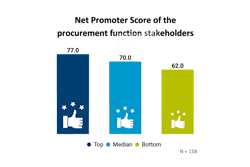
Oil and gas companies operate in dynamic and complex environments, where they face constant challenges especially in terms of supply and demand. Now with oil prices at historic lows combined with the Coronavirus disease (COVID-19) supply chain disruptions, the time has come to evaluate the supply chain and procurement strategies, sourcing techniques and costs.
Major pandemics like COVID-19 can create significant disruption to the reliable supply of oil and gas equipment/parts such as valves, turbines, compressors and more within the oil and gas value chain. The COVID-19 pandemic is a wakeup call for C-level executives to develop new business strategies in their future supply chain designs. Procurement and supply chain strategies are set to be in the forefront of critical issues plaguing oil and gas companies especially with the current downward spiral of oil prices and COVID-19.
According to a survey from the Institute for Supply Management (ISM), around 57% noted longer lead times for Tier-1 China-sourced components. Engineering, procurement and construction contractors and oil and gas project owners are currently dealing with the supply chain and procurement disruption across the globe. Many oil and gas companies worldwide realized that either their suppliers or sub-suppliers (Tier-2/Tier-3 suppliers) are based in the affected regions such as China, Italy, South Korea, and Spain. Single sourcing or sourcing everything from one geography or country has led to the current disruption. Even though some companies don’t source directly from China but their Tier-2/Tier-3 suppliers down the line do so. Oil and gas companies should be proactive in developing robust supply chain resilience and have adequate supply chain risk intelligence.
Supplier risk intelligence
Supplier risk intelligence is the process of acquiring and analyzing supplier risks in order to understand the present and future risks; support current and future sourcing and market sector strategy execution; and enable the business to better anticipate changes in the external marketplace and react before others do. Supplier risk intelligence is key to any industry and more so for the dynamic oil and gas industry. The oil and gas industry are heavily dependent on suppliers to provide complex services and critical equipment to support ongoing projects and operations. More often than not, contract management and supplier relationship management are not up to the mark, and therefore, the oil and gas companies take on supplier risks. To improve supplier relationship management, the companies should adopt a method of supplier benchmarking. Oil and gas companies need to measure the robustness and performance of different contractors for various spend categories and constantly seek dialogue, so that suppliers are in unison with the necessary obligations in terms of safety, training, equipment and staffing requirements. For contract management, some oil and gas companies with non-efficient processes such as non-compliance of contracts with established suppliers.
Supply chain mapping
Supply chain mapping is one way to mitigate the supply chain risks, especially if there is over dependence on one country or concentration of souring from one country or geography. Supply chain mapping involves thorough understanding of suppliers, including their global sites, local sites and subcontractors, as well as knowing which components or parts originate or pass through those sites. Companies who are ahead in supply chain mapping benefit when disruptions happen because they are able to quickly deduce how their supply chain could be impacted in the short to mid-term. When companies have advance knowledge of where the disruption will come from and which products will be impacted, they have lead time to execute avoidance and mitigation strategies immediately — like shaping demand by offering discounts on substitutes, buying up inventory, booking capacity at alternate sites, controlling inventory allocations and so on.
Supply chain market intelligence
Supply chain market intelligence helps companies make the right decisions about which markets to buy from, how to determine the right price to pay and what benchmarks and targets will provide the right competitive edge. Effective supply chain risk intelligence helps oil and gas companies deal with strategic supply chain challenges such as constrained capacity, infrastructure and volatile markets.
The indicators of compromise/national occupation classifications to improve and deploy best-in-class supply chain risk mitigation practices can adapt and/or implement some of the practical measures listed below:
- Understand the critical supply chain of major spend categories. This requires identifying costs and sourcing options across the supply chain for each category and determining appropriate interventions (e.g., seeking new supplier, changing specifications, altering contract terms).
- Undertake critical and non-critical supply chain bottlenecking assessment. Target for paradigm shift in the supply chain that could mean identifying alternative suppliers.
- Build custom-fit procurement processes that provide better clarity, engage suppliers early in the process. Moreover, follow through to execution and into operations.
- Manage risks across the entire spending portfolio, not just within individual projects or commodities, or splitting capital from operations spend.
- Proactively manage the supply base, select relevant suppliers, focus on alignment and sustainability (i.e., dynamic relationships) and ensure company ownership and accountability is clear to suppliers.
- Institutionalize the capabilities required for supporting procurement and supply chain activities. Today, these scarce skills are at a premium. In the next few years, it will be just as important to cultivate the right talent here as it will in the most critical technical and operational areas.
Going forward, the rethinking of supply chain strategy has already begun, but COVID-19 will accelerate the need to have decentralized global supply chain. Improved supply chain resiliency and collaborative supplier relationship management is the way forward for oil and gas companies to reduce costs in this era of low oil prices and focus on production and exploration in the most optimized way. It will be really interesting to see how oil and gas companies can effectively manage robust supplier monitoring system coupled with the adoption of best-in-class supply chain practice in 2020.










